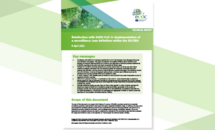Reinfection with SARS-CoV-2: implementation of a surveillance case definition within the EU/EEA
The aim of this document is to present the findings of a survey of EU/EEA countries carried out to ascertain
surveillance practices implemented to document and report suspected reinfection cases. In addition, this document summarises the available evidence on the duration of protective immunity following infection with SARS-CoV-2, addressing concerns related to reinfection, such as disease severity during a reinfection episode. The survey responses and available evidence are used to underline the rationale for the surveillance case definition proposed for suspected reinfection cases, to be reported via The European Surveillance System (TESSy).
Executive Summary
Key messages
- Reinfection with SARS-CoV-2 has been reported both within the European Union/European Economic Area (EU/EEA) and globally. This report summarises the available evidence about reinfection and duration of immunity following SARS-CoV-2 infection and describes surveillance practices implemented in EU/EEA countries to document and report suspected reinfection cases.
- Thirteen of 17 EU/EEA countries responding to a survey sent by ECDC on 28 January 2021 about existing surveillance case definitions and reporting systems for reinfection confirmed they had a national case definition, with the minimum interval between episodes described in the definition ranging from 45 to 90 days. In terms of diagnostic testing criteria, countries report different practices for identifying and counting possible SARS-CoV-2 reinfection cases.
- In 2020, a total of 1 887 possible cases of reinfection were reported to be under investigation across 12 responding EU/EEA countries.
- SARS-CoV-2 variants of concern – in particular B.1.351 and P.1 – have demonstrated a capacity to escape protective immune responses mounted by individuals that have recovered from a prior infection. It is possible that reinfections may occur more frequently in areas where there is sustained transmission of these new variants.
- Although reinfection events are rare, they are likely under-reported. In order to better ascertain the burden and impact of SARS-CoV-2 reinfection across the EU/EEA, particularly in the context of emerging variants with immune escape potential, ECDC has established a surveillance case definition for suspected reinfection, introducing new case-based and aggregated variables to improve systematic reporting via The European Surveillance System (TESSy).








